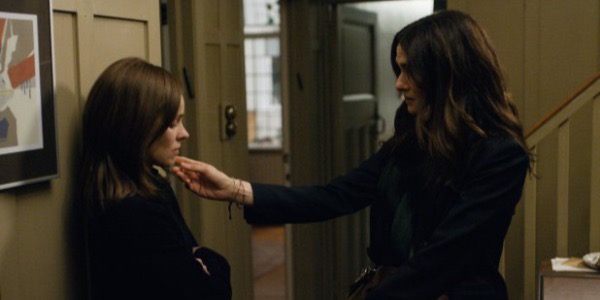DISOBEDIENCE: Another Addition To Lelio’s Interloper Cinema

Midwesterner, movie lover, cinnamon enthusiast.
Disobedience, the second film released in the U.S. this year from Chilean filmmaker Sebastián Lelio, has been marketed as a steamy romance in which Rachel Weisz and Rachel McAdams play two women whose unbridled passion for each other emerges orgasmically.
Unharmonious Marketing
In an interview with Indiewire, Lelio even played this image up, saying that he’s heard Disobedience referred to as “Jew Is The Warmest Color” — the film’s milieu is an Orthodox Jewish community in Northern London — to which he replied with a half-smirk, “I think ours is a little less problematic.”

That it is; it’s also a lot less interesting. But this is a weird concept for the director to perpetuate. Disobedience isn’t an entry into the erotic LGBTQ cinematic pantheon. I get it from a marketing perspective, but not from the perspective of a man who would presumably have quite an interest in the actual elements and themes of his own film, considering Disobedience attempts to portray struggles about returning home, repression and what you owe your family, as the secular Ronit’s (Weisz) return home following her devout father’s passing incites a rupture in the marriage of Esti (McAdams) and Dovid (Allessandro Nivola).
Film Comment also called out the tone-deaf use of Blue Is The Warmest Color as an analog for Disobedience, instead opting for Call Me By Your Hebrew Name, which tracks better. Both Guadagnino and Lelio’s films share the framework of an outsider entering a situation and affecting someone’s sexual identity.
Though Lelio’s comment about the film’s sexual content might be a weird thing to belabor, it makes me wonder how complicit he is in the film’s marketing. Or how unwilling he is to be transparent about his film, and therefore how uninterested he actually is in its thematic profile. Anyhow, Disobedience’s end product bears out this lack of interest.
To be clear, there is one sex scene in the film between Weisz and McAdams. It lasts a couple minutes, is fairly intense, and also not particularly convincing for these two people. “It feels like two brave actors giving each other an erotic workout and struggling to make their coitus distinctive, with details like Ronit tenderly spitting into Esti’s mouth,” wrote Film Comment’s Michael Sragow. The spitting scene in particular feels out of place, like an awkward one-off attempt to instill some spontaneity into this cold, pulseless drama.
Lelio’s willingness to publicly contrast his film as “less problematic” than a film with an absolutely terrible production history and much maligned depiction of lesbian sex is suspect. It comes across as one of many attempts to preserve himself from criticism, or rather, lobby his own praise as he wears wokeness like a badge for journalists to take note of.
The Depiction of Orthodox Judaism
For the same reason, I couldn’t help but be skeptical when I read Weisz (who also produced the film) describe the non-Jewish director’s approach to the film as “a cultural anthropologist.” Apparently, he had a crew of Jewish consultants and attended many services and ceremonies.
Regardless of his hours spent researching, the film’s use of devout practices come off with the fluency and lived-in-ness of boning up overnight with Rosetta Stone. For Film School Rejects, Elazar Fine wrote from the lens of an ex-Orthodox Jew about his own problems with Disobedience’s representation of Orthodox Judaism:

“With Disobedience, Sebastián Lelio continues in the rich gentilic cinematic tradition of outsiders exploiting the Orthodox Jewish community to tell stories that aren’t really about the Orthodox community, or Jewish people, at all. Lelio’s co-writer is a Jew (Rebecca Lenkiewicz, who co-wrote the brilliant Polish film Ida back in 2013), which I imagine has inoculated him from some level of criticism. But being plainly Jewish and being familiar with the intricacies of Orthodox Judaism are two very different things. Regardless as to Lenkiewicz’s familiarity with Orthodox Judaism (or the familiarity of any number of Jewish consultants who surely worked on the film), a distinct fakeness radiates through every frame of Disobedience.”
He continues, positing the possibly dubious incentives for the director to make a Jewish film, “Lelio’s interest in the Jewish community is transparently superficial. He wanted to make a movie about a lesbian affair in a repressed community that frowns on such behavior, and of the myriad communities that fit that description, he happened to choose this one. His characters purport to be Jewish, but this is not really a Jewish movie.”
After speaking suspiciously about the film’s sex scene, Fine says, “It’s a symptom of the same disease: with Disobedience, Lelio was never interested in telling a story about characters. This was merely a chance to show superficially Jewish women having forbidden sex in a hotel room.”
For the release of Lelio’s previous film, A Fantastic Woman, Elena Lazic interviewed Lelio for Seventh Row. When she asked him whether he knew any transgender people when he decided to make the film, the director responded with the following:
“I didn’t, actually. We started with a situation: what would happen if the person you loved died in your arms — but your arms were the worst place in the world for that person to die because, for some reason, you are the unwanted one? You’re rejected, but you have to inform the family, let everyone know what happened… That was the original premise.
“Then, the idea of making this story happen to a transgender woman appeared, and it was like when you hear this special sound in baseball, and you know it’s a good hit. But at the same time, we knew it could be a disaster. So, I felt the need to meet some transgender people.”
In justification for trafficking in a subject matter that’s foreign to his own life and heritage with Disobedience, the director said, “Even though I’m so far away from the [Orthodox Jewish] reality, I do understand the dynamics of a culture where the weight of religion can be strong and influential, and how that can create tension between what the community needs and the personal quest for individual freedom.”

Basically, Lelio works from a high-level perspective, worrying about the details later. This is fine in the world of high-concept cinema, but that is not the cinema Lelio is interested in. He’s making films centered around important representations of subjugated and oppressed populations within the genre of social realism. This approach is evident in the texts — they lack the voice of license, and Lelio’s sentiments about the cultural paradigms he’s working in sound as if he considers these identities and milieus solely as an aesthetic.
Protagonists as Ciphers
The central tension Lelio speaks of between freedom and religion is primarily strung in Disobedience between Ronit and this world of her past, which has marked her an outsider. Her secular assimilation is met with hostility by her former community. More specifically, Ronit is a liberated city dweller (a photographer by trade) that purposely left the devout world behind her for more metropolitan pastures.
Upon her return home, Ronit provides a paradigm shift to a group that is resistant to her new life, and their hostility for her mostly manifests in blaming her for not being with her father during his last days — a development she was completely unaware of.
Lelio builds this tension with the deft touch of a hammered teen sneaking home past curfew. He introduces the differences between Ronit and her former community during a dinner scene in the first act. She’s forced to stick up for her secular lifestyle through a series of clap-backs that make the rest of the room look short sighted, mean and unintelligent.
This hammering home of hatred from outsiders, which is bolstered by the fact that it’s rooted in unfairness (she couldn’t be there for her dying father if she didn’t know he was dying) isn’t a helpful character development nor world building; it’s a sloppy and easy way to instill conflict and drive pity towards a protagonist. As a result, I’m left feeling condescended to, as if Lelio stands above me, smacking my nose with a rolled up newspaper, “Oppression bad! No!”.
The director’s inability to create believable, organic tension completely pock-marked A Fantastic Woman, and this is something especially disconcerting for the type of films Lelio is trying to make. He thinks he’s making serious films that stare in the face of conservative issues, showing us the power of lives lived outside of prescribed social identities and norms, but without proper development of these protagonist’s interiors, his characters become ciphers for diametrically opposed viewpoints and lifestyles — a self-imposed hegemonic dialectic of progressivism against regressivism.
Lelio’s hamstrung development is rooted in his insistence on navigating relationships through thematic issues that categorize his characters, and thus reduces them to abstracts. In other words, he’s more interested in diagnosing why his subjects are culturally subjugated rather than figuring out how to articulate the emotional nuances of how that must feel. He hasn’t shown the ability to create a narrative that is anything more than the high-level maneuvering of signposts for transgender, gay or secular characters and their oppressors.

In Willow Maclay’s review of A Fantastic Woman for Nashville Scene, she took the film to task, skeptical of the use of “a bombastic depiction of transphobia” as a catalyst for making a social statement. Additionally, much like Fine accused Disobedience’s portrayal of Orthodox Judaism as fake, Maclay took Lelio to task for having a limited knowledge of trans women’s bodies.
Because a film like Disobedience exists as a similar opportunity to champion progressive social issues, I return to the film’s marketing: the tightly framed agape mouths of its stars, a moment before their rapturous touch. Echoing Maclay, I ask, who is this film for?
The marketing is doing everything it can to keep out a large demographic of conservatives — the type who consider two women kissing risqué. And as mentioned, Lelio seems to be on board with talking about the film in the same manner — as a progressive flick that centers on two women’s sexual appetite for each other. Therefore, this film isn’t exactly positioning itself to get in front of the eyes of non-progressives.
Beyond the idea that its representation of the social struggles of a closeted gay woman in a devout environment will offer a salve to some viewers, this film feels like it was made to perpetually knock against the walls of a liberal echo chamber. Because Disobedience lacks specificity in its characters, we’re left with a hollow structure of a concept and point of view his audience needs no help parsing.
Disobedience: Conclusion
Besides these larger issues of Lelio’s filmmaking, there’s still much left to be desired in his craft — for instance, his clunky mishandling of symbolism. Much like his noggin-bonking use of mirrors and Aretha Franklin in A Fantastic Woman, here you’ll find him fumbling around with wigs and photography.
But mostly, after Disobedience, I was left with the same uneasy feeling his last film evoked in me — the feeling that this isn’t Lelio’s story to tell. There is an emotional honesty that’s missing from Disobedience that, as I mentioned, feels like unlicensed trespassing. If he understands the nuances of these other cultures, gender identities and sexualities through his exhaustive research, he isn’t able to translate it on screen persuasively.
Reflecting on his research, the director said, “I became really obsessed with the culture in the process. I was really moved by the community, the music, the rituals. When they open the ark, when we see the Torah, I was like, ‘This is so powerful!’ And the narrative [the Torah tells] has been refined for centuries. That is so beautiful and effective, and I was attracted to it because I am a narrative person myself.”
Even isolated from Disobedience, this quote reads to me like cultural tourism; in tandem with the film, it’s unsurprising. With his last two films, Lelio is building quite the catalog of interloper cinema that asks the question: Why does he not make a film that mines from his own life experiences, or at least something not entirely out of the purview of his own identity? I would suggest such a transition, but I also can’t imagine giving this guy’s movies any more of my attention.
Unlike me, have you liked Lelio’s output so far? Tell us in the comments below!
Disobedience was released in the U.S. on April 27, 2018 to limited theaters and will be released the U.K. on November 30, 2018. For all international release dates, see here.
Does content like this matter to you?
Become a Member and support film journalism. Unlock access to all of Film Inquiry`s great articles. Join a community of like-minded readers who are passionate about cinema - get access to our private members Network, give back to independent filmmakers, and more.













